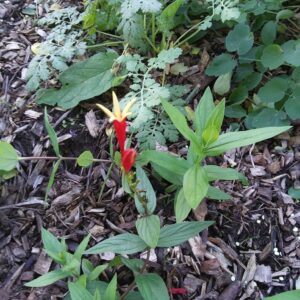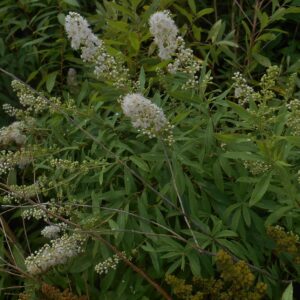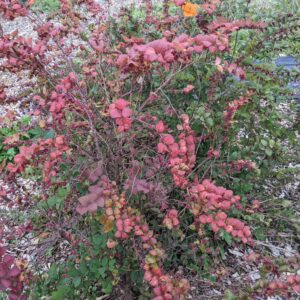Plants for Butterflies and Other Pollinators
Showing 193–200 of 223 results
-
Spigelia marilandica Carolina pink, Woodland pinkroot Z 5-9
Stems topped with showy red tubes and fireworks-like yellow, five-pointed stars flare atop the tubes in late spring to early summer and later in the north. Deadhead for rebloom
OUT OF STOCK
Stems topped with showy red tubes and fireworks-like yellow, five-pointed stars flare atop the tubes in late spring to early summer and later in the north. Deadhead for rebloom
Size: 12-24” x 6-18”
Care: part to full shade in moist to moist well-drained soil
Native: NJ to Fl west to TX
Wildlife Value: nectar for hummingbirds; deer resistant
Awards: Pennsylvania Horticultural Society Gold Medal 2023Cherokee used this to purge parasites from intestines. In garden by 1753. Philip Miller’s Dictionary “the plant “is esteemed as the best medicine (in North America) yet known for the worms.” (1768) According to Jacob Bigelow in American Medical Botany, 1817 one doctor used it as a purgative and another as a narcotic.
-
Spiraea alba Meadowsweet, Du Roi Z 3-7
This short shrub sports white flower spikes 4” long blooming from June to August, deadhead for rebloom.
This short shrub sports white flower spikes 4” long, blooming from June to August, deadhead for rebloom.
Size: 3-4’ x 3-4’
Care: sun to part shade in moist to moist well-drained soil
Native: Northeastern 2/3 of North America, Wisconsin native
Wildlife Value: nectar attracts butterflies & hosts caterpillars of Spring azure butterflies1st described in literature in 1772. Algonquin made a medicinal tea with Meadowsweet’s leaves and stems. Iroquois administered a decoction of mashed and powdered dry roots to remedy pain in the sides.
**LISTED AS OUT OF STOCK BECAUSE WE DO NOT SHIP THIS ITEM. IT IS AVAILABLE FOR PURCHASE AT OUR RETAIL LOCATION.
-
Succisa pratensis Devil’s bit scabiosus Z 5- 9
A tall, thin stem, unbranched until its upper quarter, then branching, each branch topped with its own flower head. Innumerable tiny flowers surround a global, lake-blue flower head, about the size of a ping-pong ball. Thread-like stamens poke out from the flowers all around the globe – blue too. Blooms for nearly three months mid-to-late summer into fall.
A tall, thin stem, unbranched until its upper quarter, then branching, each branch topped with its own flower head. Innumerable tiny flowers surround a global, lake-blue flower head, about the size of a ping-pong ball. Thread-like stamens poke out from the flowers all around the globe – blue too. Blooms for nearly three months mid-to-late summer into fall.
LIMITED QUANTITIES AVAILABLE, LIMIT OF 1 PER CUSTOMER PLEASE
Size: 2-4’ x 12”
Care: sun to part shade in moist to moist-well drained soil
Native: Europe to central Siberia, NW Africa
Wildlife Value: provides nectar and pollen to butterflies, moths, and beesHistorically this has made a dye, a tea, and seasoned food. It treated numerous medical conditions including scabies, eczema, fevers, wounds, syphilis and plague. Devil’s bit named for the legend that the Devil disapproved of the plant uses and attempted to destroy it by biting off its roots. First described by Swiss botanist Gaspard Bauhin in 1623, Pinax theatri botanici, with a different name. Linnaeus renamed it in Hortus Cliffortanus, 1737and then Möench renamed it to Succisa pratensis in 1794.
-
Symphoricarpos albus Snowberry Z 3-7
Small pink bell-shaped flowers turn into copious clusters of round, white berries, like miniature snowballs, grace this shrub from late summer through winter.
OUT OF STOCK
Small pink bell-shaped flowers turn into copious clusters of round, white berries, like miniature snowballs, grace this shrub from late summer through winter.
Size: 3-6’ x 3-6’
Care: sun to part shade in moist well-drained to well-drained soil
Native: Canada east to west coasts; US all states north from Virginia to California. Wisconsin native.
Wildlife Value: deer tolerant, attracts numerous birds including Hummingbirds, Towhees, Grouses, Robins, and Waxwings for nesting and food, although the fruit is poison to humans. Bees flock to the flowers’ pollen. Host for caterpillars of the Snowberry Sphinx moth and Snowberry Clearwing moth.Pauites of Oregon constructed cradle boards with the wood, sharpened the stem for digging tool and used its branches in a game of dice. The Nez Perce boiled sticks in water then used to remedy fevers, and encircled its branches around cradleboards to protect babies from ghosts. Flathead cured injured eyes with juice for the fruit and made a paste of its fruit, bark and leaves to remedy skin ailments and burns. For the Blackfoot the smoke from burning twigs blackened newly made pipes. Sioux made a diauretic from the fruit. Ojibwa speeded up convalescence for new mothers after giving birth with water infused with this. Shoshone made arrows from shoots for small birds. Collected for botany before 1753. Also collected on Lewis and Clark Expedition along the Missouri River west of Council Bluffs.
**LISTED AS OUT OF STOCK BECAUSE WE DO NOT SHIP THIS ITEM. IT IS AVAILABLE FOR PURCHASE AT OUR RETAIL LOCATION.
-
Symphoricarpos orbiculatus Coralberry Z 3-7
Baby-pink flowers in spring to early summer give way to clustered coral-colored berries that last through winter.
OUT OF STOCK
Baby-pink flowers in spring to early summer give way to clustered coral-colored berries that last through winter.
Size: 2’-5’ x 5-8’
Care: Part to full shade in moist well-drained to well-drained soil
Native: Eastern US from NY south to eastern TX, west to SD & CO.
Wildlife Value: pollen and nectar for small bees and butterfliesWas classified simultaneously by Michaux, Linnaeus, and finally Moench (1794) whose designation is used today.
-
Symphyandra pendula Bellflower Z 5-8
Panicles of creamy white bell-shaped flowers dangle over heart-shaped foliage March-June
OUT OF STOCK
Panicles of creamy white bell-shaped flowers dangle over heart-shaped foliage March-June
Size: 20” x 12”
Care: Full to part sun in well-drained soil
Native: Caucasus
Wildlife Value: attracts bees, butterflies and birdsCollected before 1830
-
Symphyandra zanzegura syn Campanula zanzegura Ring bellflower, Rock bellflower Z 5-10
Flared lilac bells hang from wiry stems all summer. Self-sows.
OUT OF STOCK
Flared petal ends of lilac bells on wiry red stems over soft, velvety leaves persist much of summer.
Size: 15” x 15”
Care: full to part shade in moist well-drained soil
Native: mountains of Armenia, Eastern Europe
Wildlife Value: attracts beesDescribed and published by Ukrainian botanist Vladimir Lipsky (1863-1937) in 1894. Reclassified as a Campanula in 1980.
-
Syneilesis aconitifolia syn. Senecio aconitifolia Shredded umbrella plant; in China, tu er san Z 3-8
Grown for its excellent foliage in dry shade. I guess “Shredded umbrella” best describes this plant with thin, dissected leaves atop a leafless stem. drooping in a rounded shape, like an umbrella, but it wouldn’t shelter from rain. Pale pink to white flowers in early to mid-summer.
OUT OF STOCK
Grown for its excellent foliage in dry shade. “Shredded umbrella” best describes this plant with thin, dissected leaves atop a leafless stem. Drooping in a rounded shape, like an umbrella, but it wouldn’t shelter from rain. Pale pink to white flowers in early to mid-summer.
Size: 3’ x 2’, spreads slowly by rhizomes
Care: part to full shade in moist, well-drained to well-drained soil. Drought tolerant once established.
Native: China, Korea & Japan and eastern Russia
Wildlife Value: Attracts bees, butterflies and birds. Deer and rabbit resistant.Described in Flora of China in 1833. Chinese used the whole plant for medicine, to relax and activate the tendons, alleviate pain around the waist and legs, and to treat most any injuries.




